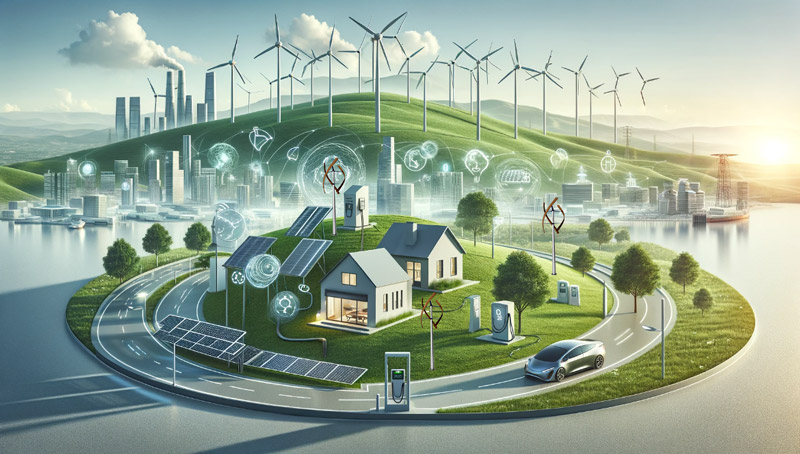Italy is a crossroads of cultures, innovation and traditions, but it is also a battlefield for one of the most significant challenges of our time: the transition towards a sustainable future.
The Italian energy balance reflects not only the country’s energy consumption and production but also its ability to adapt and innovate in response to environmental, economic and social pressures.
In this context, green energy from renewable sources such as wind, sun and water, plays a crucial role, marking the step towards reducing energy dependence on foreign countries and reducing harmful emissions.
Geothermal energy and smart grids – together with installed wind capacity and biomass energy production – are clear examples of how Italy is focusing on technological innovation and efficiency to meet its energy needs.
These efforts fit into a broader framework of energy transition, which seeks a balance between economic growth, safety and environmental protection.
All this takes the form of a central topic in the debate on sustainability and energy transition, attracting the attention of a large and diversified audience.
The energy balance and its importance
Optimising energy consumption plays a crucial role in orienting the country’s energy policies towards a more sustainable and independent future.
This indicator, which analyses energy consumption, production and import in detail, offers a complete overview of the health of the national energy system, highlighting the progress made and the areas that need greater attention.
The transition towards renewable energy sources is a hot topic in public and political debate, not only in Italy but throughout the world.
In recent years, Italy has taken significant steps in this direction. For example, according to data from the ENERGY SERVICES MANAGER (GSE), Italy has seen an increase in the share of energy produced from renewable sources, reaching important milestones that bring it closer to the objectives set by the European Union for 2030.
Another fundamental aspect of the energy balance is efficiency. The Italian Government has implemented various measures – such as incentives for the redevelopment of buildings and investments in more efficient technologies – to reduce overall consumption. These policies not only help reduce the country’s carbon footprint but also stimulate innovation and growth in the green technology sector.
Energy dependence on foreign countries is another challenge that Italy is facing with determination.
Through the analysis of energy management at a national level, it is clear how the country is trying to reduce this dependence by increasing the internal energy production from renewable sources and improving the consumption efficiency.
This not only increases national security but also reduces vulnerability to volatile international markets.

Technological innovation plays a key role in this process. The adoption of solutions such as smart grids, geothermal energy and solar and wind energy storage systems is transforming the Italian energy landscape, making it more flexible, efficient and less dependent on fossil fuels.
However, it is necessary to raise awareness among citizens and businesses of the importance of energy efficiency and responsible consumption. Through targeted incentive policies, Italy can stimulate the development of new renewable plants, further reducing its external dependence.
Innovation in the sector of renewable energy and energy efficiency technologies is also of fundamental importance to keep Italy at the forefront of the global transition.
Smart grid and wind power: innovation at the service of efficiency
Smart grids and wind energy represent two fundamental pillars of the energy transition in Italy, aiming for a more sustainable, efficient and resilient system. These innovative technologies are revolutionising the way energy is produced, distributed and consumed, bringing benefits not only in environmental but also economic terms.
Smart grids, with their ability to manage the electricity grid more intelligently and flexibly, are essential for the effective integration of renewable sources such as wind. Thanks to real-time data and advanced technology, they optimise the use of resources, reducing waste and improving the satisfaction of energy needs in a sustainable way.
For example, experimental projects in several Italian regions have demonstrated how the active demand management and the use of storage systems can balance intermittent wind energy production, stabilising the grid and reducing the need for fossil energy sources.
Wind energy, for its part, is one of the most promising and rapidly expanding renewable sources in Italy. With a territory characterised by an excellent wind potential, Italy has seen a substantial growth in installed capacity in recent years.
Innovative projects – such as the installation of offshore wind turbines in Italian territorial waters – are overcoming some of the traditional challenges related to territorial acceptance and production variability.
These projects not only contribute to diversifying the national energy mix but also offer new opportunities for local economic development, creating jobs and stimulating technological innovation.
The active participation of local communities in decision-making processes, together with compensation strategies and investments in environmental conservation projects, can improve acceptance and maximise the benefits of renewable energy.

What can be done?
- Strengthen collaboration between the public and private sectors: To accelerate the development and integration of smart grids and wind energy, a close collaboration between government, manufacturing companies, research institutes and civil society is essential. And perhaps, encourage the creation of energy communities.
- Investing in education and training: Increase public awareness of the importance of renewable energy and develop specific skills in the field of innovative technologies.
- Further develop grid infrastructure: To support increased wind capacity and smart grid integration, Italy must continue to invest in transmission and distribution infrastructure.
Through these strategies, Italy can not only improve its energy efficiency and reduce environmental impact but also position itself as a leader in the transition towards a sustainable and innovative future.
The environmental impact of energy: a necessary evaluation
When we talk about the energy balance we must not only evaluate the economic impact, but also what the environmental impact will be in the years to come based on the choices of a country.
For example, the Po Valley already appears to be one of the most polluted areas in Europe, thus a study that evaluates this situation must necessarily be on the agenda.
In short, analysing the environmental implications associated with energy consumption helps us understand how the choices we make today can affect the planet tomorrow.
The current energy mix is an amalgam of renewable and non-renewable sources, each with its own specificities in terms of environmental impact. Fossil sources – such as oil, coal and natural gas – are among the major contributors to greenhouse gas emissions, environmental degradation and air pollution.
Their combustion releases significant quantities of CO2, contributing to global warming and climate change. An emblematic example is represented by coal-fired power plants, which – despite emissions reduction technologies – remain highly polluting.
On the other hand, renewable sources – such as solar, wind, hydropower and geothermal energy – offer cleaner alternatives, although not without challenges.
It is up to us to take up this challenge.


